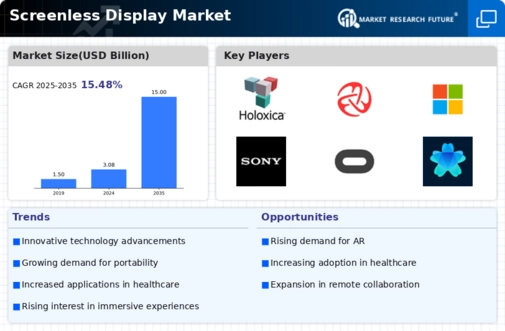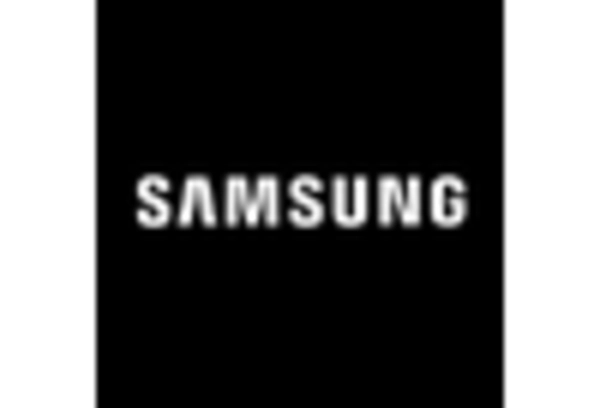-
EXECUTIVE SUMMARY
-
Market Overview
-
Key Findings
-
Market Segmentation
-
Competitive Landscape
-
Challenges and Opportunities
-
Future Outlook
-
\r\n
-
MARKET INTRODUCTION
-
Definition
-
Scope of the study
- Research Objective
- Assumption
- Limitations
-
RESEARCH METHODOLOGY
-
Overview
-
Data Mining
-
Secondary Research
-
Primary Research
- Primary Interviews and Information Gathering Process
- Breakdown of Primary Respondents
-
Forecasting Model
-
Market Size Estimation
- Bottom-Up Approach
- Top-Down Approach
-
Data Triangulation
-
Validation
-
\r\n
-
MARKET DYNAMICS
-
Overview
-
Drivers
-
Restraints
-
Opportunities
-
MARKET FACTOR ANALYSIS
-
Value chain Analysis
-
Porter's Five Forces Analysis
- Bargaining Power of Suppliers
- Bargaining Power of Buyers
- Threat of New Entrants
- Threat of Substitutes
- Intensity of Rivalry
-
COVID-19 Impact Analysis
- Market Impact Analysis
- Regional Impact
- Opportunity and Threat Analysis
-
\r\n
-
SCREENLESS DISPLAY MARKET, BY TECHNOLOGY (USD BILLION)
-
Visual Display Unit
-
Digital Light Processing
-
Light Field Technology
-
Retinal Display
-
SCREENLESS DISPLAY MARKET, BY APPLICATION (USD BILLION)
-
Healthcare
-
Gaming
-
Aerospace
-
Automotive
-
Education
-
SCREENLESS DISPLAY MARKET, BY END USE (USD BILLION)
-
Consumer Electronics
-
Commercial
-
Industrial
-
Military
-
SCREENLESS DISPLAY MARKET, BY COMPONENT (USD BILLION)
-
Hardware
-
Software
-
Services
-
SCREENLESS DISPLAY MARKET, BY REGIONAL (USD BILLION)
-
North America
- US
- Canada
-
Europe
- Germany
- UK
- France
- Russia
- Italy
- Spain
- Rest of Europe
-
APAC
- China
- India
- Japan
- South Korea
- Malaysia
- Thailand
- Indonesia
- Rest of APAC
-
South America
- Brazil
- Mexico
- Argentina
- Rest of South America
-
MEA
- GCC Countries
- South Africa
- Rest of MEA
-
\r\n
-
COMPETITIVE LANDSCAPE
-
Overview
-
Competitive Analysis
-
Market share Analysis
-
Major Growth Strategy in the Screenless Display Market
-
Competitive Benchmarking
-
Leading Players in Terms of Number of Developments in the Screenless Display Market
-
Key developments and growth strategies
- New Product Launch/Service Deployment
- Merger & Acquisitions
- Joint Ventures
-
Major Players Financial Matrix
- Sales and Operating Income
- Major Players R&D Expenditure. 2023
-
COMPANY PROFILES
-
Holoxica
- Financial Overview
- Products Offered
- Key Developments
- SWOT Analysis
- Key Strategies
-
MicroVision
- Financial Overview
- Products Offered
- Key Developments
- SWOT Analysis
- Key Strategies
-
Facebook
- Financial Overview
- Products Offered
- Key Developments
- SWOT Analysis
- Key Strategies
-
Microsoft
- Financial Overview
- Products Offered
- Key Developments
- SWOT Analysis
- Key Strategies
-
Samsung Electronics
- Financial Overview
- Products Offered
- Key Developments
- SWOT Analysis
- Key Strategies
-
Sony
- Financial Overview
- Products Offered
- Key Developments
- SWOT Analysis
- Key Strategies
-
Oculus
- Financial Overview
- Products Offered
- Key Developments
- SWOT Analysis
- Key Strategies
-
VividQ
- Financial Overview
- Products Offered
- Key Developments
- SWOT Analysis
- Key Strategies
-
Meta
- Financial Overview
- Products Offered
- Key Developments
- SWOT Analysis
- Key Strategies
-
Google
- Financial Overview
- Products Offered
- Key Developments
- SWOT Analysis
- Key Strategies
-
Displax
- Financial Overview
- Products Offered
- Key Developments
- SWOT Analysis
- Key Strategies
-
Apple
- Financial Overview
- Products Offered
- Key Developments
- SWOT Analysis
- Key Strategies
-
Light Field Lab
- Financial Overview
- Products Offered
- Key Developments
- SWOT Analysis
- Key Strategies
-
Sony Interactive Entertainment
- Financial Overview
- Products Offered
- Key Developments
- SWOT Analysis
- Key Strategies
-
Amazon
- Financial Overview
- Products Offered
- Key Developments
- SWOT Analysis
- Key Strategies
-
APPENDIX
-
References
-
Related Reports
-
LIST OF TABLES
-
\r\n
-
LIST OF ASSUMPTIONS
-
NORTH AMERICA SCREENLESS DISPLAY MARKET SIZE ESTIMATES & FORECAST, BY TECHNOLOGY, 2019-2035 (USD BILLIONS)
-
NORTH AMERICA SCREENLESS DISPLAY MARKET SIZE ESTIMATES & FORECAST, BY APPLICATION, 2019-2035 (USD BILLIONS)
-
NORTH AMERICA SCREENLESS DISPLAY MARKET SIZE ESTIMATES & FORECAST, BY END USE, 2019-2035 (USD BILLIONS)
-
NORTH AMERICA SCREENLESS DISPLAY MARKET SIZE ESTIMATES & FORECAST, BY COMPONENT, 2019-2035 (USD BILLIONS)
-
NORTH AMERICA SCREENLESS DISPLAY MARKET SIZE ESTIMATES & FORECAST, BY REGIONAL, 2019-2035 (USD BILLIONS)
-
US SCREENLESS DISPLAY MARKET SIZE ESTIMATES & FORECAST, BY TECHNOLOGY, 2019-2035 (USD BILLIONS)
-
US SCREENLESS DISPLAY MARKET SIZE ESTIMATES & FORECAST, BY APPLICATION, 2019-2035 (USD BILLIONS)
-
US SCREENLESS DISPLAY MARKET SIZE ESTIMATES & FORECAST, BY END USE, 2019-2035 (USD BILLIONS)
-
US SCREENLESS DISPLAY MARKET SIZE ESTIMATES & FORECAST, BY COMPONENT, 2019-2035 (USD BILLIONS)
-
US SCREENLESS DISPLAY MARKET SIZE ESTIMATES & FORECAST, BY REGIONAL, 2019-2035 (USD BILLIONS)
-
CANADA SCREENLESS DISPLAY MARKET SIZE ESTIMATES & FORECAST, BY TECHNOLOGY, 2019-2035 (USD BILLIONS)
-
CANADA SCREENLESS DISPLAY MARKET SIZE ESTIMATES & FORECAST, BY APPLICATION, 2019-2035 (USD BILLIONS)
-
CANADA SCREENLESS DISPLAY MARKET SIZE ESTIMATES & FORECAST, BY END USE, 2019-2035 (USD BILLIONS)
-
CANADA SCREENLESS DISPLAY MARKET SIZE ESTIMATES & FORECAST, BY COMPONENT, 2019-2035 (USD BILLIONS)
-
CANADA SCREENLESS DISPLAY MARKET SIZE ESTIMATES & FORECAST, BY REGIONAL, 2019-2035 (USD BILLIONS)
-
EUROPE SCREENLESS DISPLAY MARKET SIZE ESTIMATES & FORECAST, BY TECHNOLOGY, 2019-2035 (USD BILLIONS)
-
EUROPE SCREENLESS DISPLAY MARKET SIZE ESTIMATES & FORECAST, BY APPLICATION, 2019-2035 (USD BILLIONS)
-
EUROPE SCREENLESS DISPLAY MARKET SIZE ESTIMATES & FORECAST, BY END USE, 2019-2035 (USD BILLIONS)
-
EUROPE SCREENLESS DISPLAY MARKET SIZE ESTIMATES & FORECAST, BY COMPONENT, 2019-2035 (USD BILLIONS)
-
EUROPE SCREENLESS DISPLAY MARKET SIZE ESTIMATES & FORECAST, BY REGIONAL, 2019-2035 (USD BILLIONS)
-
GERMANY SCREENLESS DISPLAY MARKET SIZE ESTIMATES & FORECAST, BY TECHNOLOGY, 2019-2035 (USD BILLIONS)
-
GERMANY SCREENLESS DISPLAY MARKET SIZE ESTIMATES & FORECAST, BY APPLICATION, 2019-2035 (USD BILLIONS)
-
GERMANY SCREENLESS DISPLAY MARKET SIZE ESTIMATES & FORECAST, BY END USE, 2019-2035 (USD BILLIONS)
-
GERMANY SCREENLESS DISPLAY MARKET SIZE ESTIMATES & FORECAST, BY COMPONENT, 2019-2035 (USD BILLIONS)
-
GERMANY SCREENLESS DISPLAY MARKET SIZE ESTIMATES & FORECAST, BY REGIONAL, 2019-2035 (USD BILLIONS)
-
UK SCREENLESS DISPLAY MARKET SIZE ESTIMATES & FORECAST, BY TECHNOLOGY, 2019-2035 (USD BILLIONS)
-
UK SCREENLESS DISPLAY MARKET SIZE ESTIMATES & FORECAST, BY APPLICATION, 2019-2035 (USD BILLIONS)
-
UK SCREENLESS DISPLAY MARKET SIZE ESTIMATES & FORECAST, BY END USE, 2019-2035 (USD BILLIONS)
-
UK SCREENLESS DISPLAY MARKET SIZE ESTIMATES & FORECAST, BY COMPONENT, 2019-2035 (USD BILLIONS)
-
UK SCREENLESS DISPLAY MARKET SIZE ESTIMATES & FORECAST, BY REGIONAL, 2019-2035 (USD BILLIONS)
-
FRANCE SCREENLESS DISPLAY MARKET SIZE ESTIMATES & FORECAST, BY TECHNOLOGY, 2019-2035 (USD BILLIONS)
-
FRANCE SCREENLESS DISPLAY MARKET SIZE ESTIMATES & FORECAST, BY APPLICATION, 2019-2035 (USD BILLIONS)
-
FRANCE SCREENLESS DISPLAY MARKET SIZE ESTIMATES & FORECAST, BY END USE, 2019-2035 (USD BILLIONS)
-
FRANCE SCREENLESS DISPLAY MARKET SIZE ESTIMATES & FORECAST, BY COMPONENT, 2019-2035 (USD BILLIONS)
-
FRANCE SCREENLESS DISPLAY MARKET SIZE ESTIMATES & FORECAST, BY REGIONAL, 2019-2035 (USD BILLIONS)
-
RUSSIA SCREENLESS DISPLAY MARKET SIZE ESTIMATES & FORECAST, BY TECHNOLOGY, 2019-2035 (USD BILLIONS)
-
RUSSIA SCREENLESS DISPLAY MARKET SIZE ESTIMATES & FORECAST, BY APPLICATION, 2019-2035 (USD BILLIONS)
-
RUSSIA SCREENLESS DISPLAY MARKET SIZE ESTIMATES & FORECAST, BY END USE, 2019-2035 (USD BILLIONS)
-
RUSSIA SCREENLESS DISPLAY MARKET SIZE ESTIMATES & FORECAST, BY COMPONENT, 2019-2035 (USD BILLIONS)
-
RUSSIA SCREENLESS DISPLAY MARKET SIZE ESTIMATES & FORECAST, BY REGIONAL, 2019-2035 (USD BILLIONS)
-
ITALY SCREENLESS DISPLAY MARKET SIZE ESTIMATES & FORECAST, BY TECHNOLOGY, 2019-2035 (USD BILLIONS)
-
ITALY SCREENLESS DISPLAY MARKET SIZE ESTIMATES & FORECAST, BY APPLICATION, 2019-2035 (USD BILLIONS)
-
ITALY SCREENLESS DISPLAY MARKET SIZE ESTIMATES & FORECAST, BY END USE, 2019-2035 (USD BILLIONS)
-
ITALY SCREENLESS DISPLAY MARKET SIZE ESTIMATES & FORECAST, BY COMPONENT, 2019-2035 (USD BILLIONS)
-
ITALY SCREENLESS DISPLAY MARKET SIZE ESTIMATES & FORECAST, BY REGIONAL, 2019-2035 (USD BILLIONS)
-
SPAIN SCREENLESS DISPLAY MARKET SIZE ESTIMATES & FORECAST, BY TECHNOLOGY, 2019-2035 (USD BILLIONS)
-
SPAIN SCREENLESS DISPLAY MARKET SIZE ESTIMATES & FORECAST, BY APPLICATION, 2019-2035 (USD BILLIONS)
-
SPAIN SCREENLESS DISPLAY MARKET SIZE ESTIMATES & FORECAST, BY END USE, 2019-2035 (USD BILLIONS)
-
SPAIN SCREENLESS DISPLAY MARKET SIZE ESTIMATES & FORECAST, BY COMPONENT, 2019-2035 (USD BILLIONS)
-
SPAIN SCREENLESS DISPLAY MARKET SIZE ESTIMATES & FORECAST, BY REGIONAL, 2019-2035 (USD BILLIONS)
-
REST OF EUROPE SCREENLESS DISPLAY MARKET SIZE ESTIMATES & FORECAST, BY TECHNOLOGY, 2019-2035 (USD BILLIONS)
-
REST OF EUROPE SCREENLESS DISPLAY MARKET SIZE ESTIMATES & FORECAST, BY APPLICATION, 2019-2035 (USD BILLIONS)
-
REST OF EUROPE SCREENLESS DISPLAY MARKET SIZE ESTIMATES & FORECAST, BY END USE, 2019-2035 (USD BILLIONS)
-
REST OF EUROPE SCREENLESS DISPLAY MARKET SIZE ESTIMATES & FORECAST, BY COMPONENT, 2019-2035 (USD BILLIONS)
-
REST OF EUROPE SCREENLESS DISPLAY MARKET SIZE ESTIMATES & FORECAST, BY REGIONAL, 2019-2035 (USD BILLIONS)
-
APAC SCREENLESS DISPLAY MARKET SIZE ESTIMATES & FORECAST, BY TECHNOLOGY, 2019-2035 (USD BILLIONS)
-
APAC SCREENLESS DISPLAY MARKET SIZE ESTIMATES & FORECAST, BY APPLICATION, 2019-2035 (USD BILLIONS)
-
APAC SCREENLESS DISPLAY MARKET SIZE ESTIMATES & FORECAST, BY END USE, 2019-2035 (USD BILLIONS)
-
APAC SCREENLESS DISPLAY MARKET SIZE ESTIMATES & FORECAST, BY COMPONENT, 2019-2035 (USD BILLIONS)
-
APAC SCREENLESS DISPLAY MARKET SIZE ESTIMATES & FORECAST, BY REGIONAL, 2019-2035 (USD BILLIONS)
-
CHINA SCREENLESS DISPLAY MARKET SIZE ESTIMATES & FORECAST, BY TECHNOLOGY, 2019-2035 (USD BILLIONS)
-
CHINA SCREENLESS DISPLAY MARKET SIZE ESTIMATES & FORECAST, BY APPLICATION, 2019-2035 (USD BILLIONS)
-
CHINA SCREENLESS DISPLAY MARKET SIZE ESTIMATES & FORECAST, BY END USE, 2019-2035 (USD BILLIONS)
-
CHINA SCREENLESS DISPLAY MARKET SIZE ESTIMATES & FORECAST, BY COMPONENT, 2019-2035 (USD BILLIONS)
-
CHINA SCREENLESS DISPLAY MARKET SIZE ESTIMATES & FORECAST, BY REGIONAL, 2019-2035 (USD BILLIONS)
-
INDIA SCREENLESS DISPLAY MARKET SIZE ESTIMATES & FORECAST, BY TECHNOLOGY, 2019-2035 (USD BILLIONS)
-
INDIA SCREENLESS DISPLAY MARKET SIZE ESTIMATES & FORECAST, BY APPLICATION, 2019-2035 (USD BILLIONS)
-
INDIA SCREENLESS DISPLAY MARKET SIZE ESTIMATES & FORECAST, BY END USE, 2019-2035 (USD BILLIONS)
-
INDIA SCREENLESS DISPLAY MARKET SIZE ESTIMATES & FORECAST, BY COMPONENT, 2019-2035 (USD BILLIONS)
-
INDIA SCREENLESS DISPLAY MARKET SIZE ESTIMATES & FORECAST, BY REGIONAL, 2019-2035 (USD BILLIONS)
-
JAPAN SCREENLESS DISPLAY MARKET SIZE ESTIMATES & FORECAST, BY TECHNOLOGY, 2019-2035 (USD BILLIONS)
-
JAPAN SCREENLESS DISPLAY MARKET SIZE ESTIMATES & FORECAST, BY APPLICATION, 2019-2035 (USD BILLIONS)
-
JAPAN SCREENLESS DISPLAY MARKET SIZE ESTIMATES & FORECAST, BY END USE, 2019-2035 (USD BILLIONS)
-
JAPAN SCREENLESS DISPLAY MARKET SIZE ESTIMATES & FORECAST, BY COMPONENT, 2019-2035 (USD BILLIONS)
-
JAPAN SCREENLESS DISPLAY MARKET SIZE ESTIMATES & FORECAST, BY REGIONAL, 2019-2035 (USD BILLIONS)
-
SOUTH KOREA SCREENLESS DISPLAY MARKET SIZE ESTIMATES & FORECAST, BY TECHNOLOGY, 2019-2035 (USD BILLIONS)
-
SOUTH KOREA SCREENLESS DISPLAY MARKET SIZE ESTIMATES & FORECAST, BY APPLICATION, 2019-2035 (USD BILLIONS)
-
SOUTH KOREA SCREENLESS DISPLAY MARKET SIZE ESTIMATES & FORECAST, BY END USE, 2019-2035 (USD BILLIONS)
-
SOUTH KOREA SCREENLESS DISPLAY MARKET SIZE ESTIMATES & FORECAST, BY COMPONENT, 2019-2035 (USD BILLIONS)
-
SOUTH KOREA SCREENLESS DISPLAY MARKET SIZE ESTIMATES & FORECAST, BY REGIONAL, 2019-2035 (USD BILLIONS)
-
MALAYSIA SCREENLESS DISPLAY MARKET SIZE ESTIMATES & FORECAST, BY TECHNOLOGY, 2019-2035 (USD BILLIONS)
-
MALAYSIA SCREENLESS DISPLAY MARKET SIZE ESTIMATES & FORECAST, BY APPLICATION, 2019-2035 (USD BILLIONS)
-
MALAYSIA SCREENLESS DISPLAY MARKET SIZE ESTIMATES & FORECAST, BY END USE, 2019-2035 (USD BILLIONS)
-
MALAYSIA SCREENLESS DISPLAY MARKET SIZE ESTIMATES & FORECAST, BY COMPONENT, 2019-2035 (USD BILLIONS)
-
MALAYSIA SCREENLESS DISPLAY MARKET SIZE ESTIMATES & FORECAST, BY REGIONAL, 2019-2035 (USD BILLIONS)
-
THAILAND SCREENLESS DISPLAY MARKET SIZE ESTIMATES & FORECAST, BY TECHNOLOGY, 2019-2035 (USD BILLIONS)
-
THAILAND SCREENLESS DISPLAY MARKET SIZE ESTIMATES & FORECAST, BY APPLICATION, 2019-2035 (USD BILLIONS)
-
THAILAND SCREENLESS DISPLAY MARKET SIZE ESTIMATES & FORECAST, BY END USE, 2019-2035 (USD BILLIONS)
-
THAILAND SCREENLESS DISPLAY MARKET SIZE ESTIMATES & FORECAST, BY COMPONENT, 2019-2035 (USD BILLIONS)
-
THAILAND SCREENLESS DISPLAY MARKET SIZE ESTIMATES & FORECAST, BY REGIONAL, 2019-2035 (USD BILLIONS)
-
INDONESIA SCREENLESS DISPLAY MARKET SIZE ESTIMATES & FORECAST, BY TECHNOLOGY, 2019-2035 (USD BILLIONS)
-
INDONESIA SCREENLESS DISPLAY MARKET SIZE ESTIMATES & FORECAST, BY APPLICATION, 2019-2035 (USD BILLIONS)
-
INDONESIA SCREENLESS DISPLAY MARKET SIZE ESTIMATES & FORECAST, BY END USE, 2019-2035 (USD BILLIONS)
-
INDONESIA SCREENLESS DISPLAY MARKET SIZE ESTIMATES & FORECAST, BY COMPONENT, 2019-2035 (USD BILLIONS)
-
INDONESIA SCREENLESS DISPLAY MARKET SIZE ESTIMATES & FORECAST, BY REGIONAL, 2019-2035 (USD BILLIONS)
-
REST OF APAC SCREENLESS DISPLAY MARKET SIZE ESTIMATES & FORECAST, BY TECHNOLOGY, 2019-2035 (USD BILLIONS)
-
REST OF APAC SCREENLESS DISPLAY MARKET SIZE ESTIMATES & FORECAST, BY APPLICATION, 2019-2035 (USD BILLIONS)
-
REST OF APAC SCREENLESS DISPLAY MARKET SIZE ESTIMATES & FORECAST, BY END USE, 2019-2035 (USD BILLIONS)
-
REST OF APAC SCREENLESS DISPLAY MARKET SIZE ESTIMATES & FORECAST, BY COMPONENT, 2019-2035 (USD BILLIONS)
-
REST OF APAC SCREENLESS DISPLAY MARKET SIZE ESTIMATES & FORECAST, BY REGIONAL, 2019-2035 (USD BILLIONS)
-
SOUTH AMERICA SCREENLESS DISPLAY MARKET SIZE ESTIMATES & FORECAST, BY TECHNOLOGY, 2019-2035 (USD BILLIONS)
-
SOUTH AMERICA SCREENLESS DISPLAY MARKET SIZE ESTIMATES & FORECAST, BY APPLICATION, 2019-2035 (USD BILLIONS)
-
SOUTH AMERICA SCREENLESS DISPLAY MARKET SIZE ESTIMATES & FORECAST, BY END USE, 2019-2035 (USD BILLIONS)
-
SOUTH AMERICA SCREENLESS DISPLAY MARKET SIZE ESTIMATES & FORECAST, BY COMPONENT, 2019-2035 (USD BILLIONS)
-
SOUTH AMERICA SCREENLESS DISPLAY MARKET SIZE ESTIMATES & FORECAST, BY REGIONAL, 2019-2035 (USD BILLIONS)
-
BRAZIL SCREENLESS DISPLAY MARKET SIZE ESTIMATES & FORECAST, BY TECHNOLOGY, 2019-2035 (USD BILLIONS)
-
BRAZIL SCREENLESS DISPLAY MARKET SIZE ESTIMATES & FORECAST, BY APPLICATION, 2019-2035 (USD BILLIONS)
-
BRAZIL SCREENLESS DISPLAY MARKET SIZE ESTIMATES & FORECAST, BY END USE, 2019-2035 (USD BILLIONS)
-
BRAZIL SCREENLESS DISPLAY MARKET SIZE ESTIMATES & FORECAST, BY COMPONENT, 2019-2035 (USD BILLIONS)
-
BRAZIL SCREENLESS DISPLAY MARKET SIZE ESTIMATES & FORECAST, BY REGIONAL, 2019-2035 (USD BILLIONS)
-
MEXICO SCREENLESS DISPLAY MARKET SIZE ESTIMATES & FORECAST, BY TECHNOLOGY, 2019-2035 (USD BILLIONS)
-
MEXICO SCREENLESS DISPLAY MARKET SIZE ESTIMATES & FORECAST, BY APPLICATION, 2019-2035 (USD BILLIONS)
-
MEXICO SCREENLESS DISPLAY MARKET SIZE ESTIMATES & FORECAST, BY END USE, 2019-2035 (USD BILLIONS)
-
MEXICO SCREENLESS DISPLAY MARKET SIZE ESTIMATES & FORECAST, BY COMPONENT, 2019-2035 (USD BILLIONS)
-
MEXICO SCREENLESS DISPLAY MARKET SIZE ESTIMATES & FORECAST, BY REGIONAL, 2019-2035 (USD BILLIONS)
-
ARGENTINA SCREENLESS DISPLAY MARKET SIZE ESTIMATES & FORECAST, BY TECHNOLOGY, 2019-2035 (USD BILLIONS)
-
ARGENTINA SCREENLESS DISPLAY MARKET SIZE ESTIMATES & FORECAST, BY APPLICATION, 2019-2035 (USD BILLIONS)
-
ARGENTINA SCREENLESS DISPLAY MARKET SIZE ESTIMATES & FORECAST, BY END USE, 2019-2035 (USD BILLIONS)
-
ARGENTINA SCREENLESS DISPLAY MARKET SIZE ESTIMATES & FORECAST, BY COMPONENT, 2019-2035 (USD BILLIONS)
-
ARGENTINA SCREENLESS DISPLAY MARKET SIZE ESTIMATES & FORECAST, BY REGIONAL, 2019-2035 (USD BILLIONS)
-
REST OF SOUTH AMERICA SCREENLESS DISPLAY MARKET SIZE ESTIMATES & FORECAST, BY TECHNOLOGY, 2019-2035 (USD BILLIONS)
-
REST OF SOUTH AMERICA SCREENLESS DISPLAY MARKET SIZE ESTIMATES & FORECAST, BY APPLICATION, 2019-2035 (USD BILLIONS)
-
REST OF SOUTH AMERICA SCREENLESS DISPLAY MARKET SIZE ESTIMATES & FORECAST, BY END USE, 2019-2035 (USD BILLIONS)
-
REST OF SOUTH AMERICA SCREENLESS DISPLAY MARKET SIZE ESTIMATES & FORECAST, BY COMPONENT, 2019-2035 (USD BILLIONS)
-
REST OF SOUTH AMERICA SCREENLESS DISPLAY MARKET SIZE ESTIMATES & FORECAST, BY REGIONAL, 2019-2035 (USD BILLIONS)
-
MEA SCREENLESS DISPLAY MARKET SIZE ESTIMATES & FORECAST, BY TECHNOLOGY, 2019-2035 (USD BILLIONS)
-
MEA SCREENLESS DISPLAY MARKET SIZE ESTIMATES & FORECAST, BY APPLICATION, 2019-2035 (USD BILLIONS)
-
MEA SCREENLESS DISPLAY MARKET SIZE ESTIMATES & FORECAST, BY END USE, 2019-2035 (USD BILLIONS)
-
MEA SCREENLESS DISPLAY MARKET SIZE ESTIMATES & FORECAST, BY COMPONENT, 2019-2035 (USD BILLIONS)
-
MEA SCREENLESS DISPLAY MARKET SIZE ESTIMATES & FORECAST, BY REGIONAL, 2019-2035 (USD BILLIONS)
-
GCC COUNTRIES SCREENLESS DISPLAY MARKET SIZE ESTIMATES & FORECAST, BY TECHNOLOGY, 2019-2035 (USD BILLIONS)
-
GCC COUNTRIES SCREENLESS DISPLAY MARKET SIZE ESTIMATES & FORECAST, BY APPLICATION, 2019-2035 (USD BILLIONS)
-
GCC COUNTRIES SCREENLESS DISPLAY MARKET SIZE ESTIMATES & FORECAST, BY END USE, 2019-2035 (USD BILLIONS)
-
GCC COUNTRIES SCREENLESS DISPLAY MARKET SIZE ESTIMATES & FORECAST, BY COMPONENT, 2019-2035 (USD BILLIONS)
-
GCC COUNTRIES SCREENLESS DISPLAY MARKET SIZE ESTIMATES & FORECAST, BY REGIONAL, 2019-2035 (USD BILLIONS)
-
SOUTH AFRICA SCREENLESS DISPLAY MARKET SIZE ESTIMATES & FORECAST, BY TECHNOLOGY, 2019-2035 (USD BILLIONS)
-
SOUTH AFRICA SCREENLESS DISPLAY MARKET SIZE ESTIMATES & FORECAST, BY APPLICATION, 2019-2035 (USD BILLIONS)
-
SOUTH AFRICA SCREENLESS DISPLAY MARKET SIZE ESTIMATES & FORECAST, BY END USE, 2019-2035 (USD BILLIONS)
-
SOUTH AFRICA SCREENLESS DISPLAY MARKET SIZE ESTIMATES & FORECAST, BY COMPONENT, 2019-2035 (USD BILLIONS)
-
SOUTH AFRICA SCREENLESS DISPLAY MARKET SIZE ESTIMATES & FORECAST, BY REGIONAL, 2019-2035 (USD BILLIONS)
-
REST OF MEA SCREENLESS DISPLAY MARKET SIZE ESTIMATES & FORECAST, BY TECHNOLOGY, 2019-2035 (USD BILLIONS)
-
REST OF MEA SCREENLESS DISPLAY MARKET SIZE ESTIMATES & FORECAST, BY APPLICATION, 2019-2035 (USD BILLIONS)
-
REST OF MEA SCREENLESS DISPLAY MARKET SIZE ESTIMATES & FORECAST, BY END USE, 2019-2035 (USD BILLIONS)
-
REST OF MEA SCREENLESS DISPLAY MARKET SIZE ESTIMATES & FORECAST, BY COMPONENT, 2019-2035 (USD BILLIONS)
-
REST OF MEA SCREENLESS DISPLAY MARKET SIZE ESTIMATES & FORECAST, BY REGIONAL, 2019-2035 (USD BILLIONS)
-
PRODUCT LAUNCH/PRODUCT DEVELOPMENT/APPROVAL
-
ACQUISITION/PARTNERSHIP
-
\r\n
-
\r\n
-
\r\n
-
\r\n
-
\r\n
-
\r\n
-
\r\n
-
\r\n
-
\r\n
-
\r\n
-
\r\n
-
\r\n
-
\r\n
-
\r\n
-
\r\n
-
LIST OF FIGURES
-
\r\n
-
MARKET SYNOPSIS
-
NORTH AMERICA SCREENLESS DISPLAY MARKET ANALYSIS
-
US SCREENLESS DISPLAY MARKET ANALYSIS BY TECHNOLOGY
-
US SCREENLESS DISPLAY MARKET ANALYSIS BY APPLICATION
-
US SCREENLESS DISPLAY MARKET ANALYSIS BY END USE
-
US SCREENLESS DISPLAY MARKET ANALYSIS BY COMPONENT
-
US SCREENLESS DISPLAY MARKET ANALYSIS BY REGIONAL
-
CANADA SCREENLESS DISPLAY MARKET ANALYSIS BY TECHNOLOGY
-
CANADA SCREENLESS DISPLAY MARKET ANALYSIS BY APPLICATION
-
CANADA SCREENLESS DISPLAY MARKET ANALYSIS BY END USE
-
CANADA SCREENLESS DISPLAY MARKET ANALYSIS BY COMPONENT
-
CANADA SCREENLESS DISPLAY MARKET ANALYSIS BY REGIONAL
-
EUROPE SCREENLESS DISPLAY MARKET ANALYSIS
-
GERMANY SCREENLESS DISPLAY MARKET ANALYSIS BY TECHNOLOGY
-
GERMANY SCREENLESS DISPLAY MARKET ANALYSIS BY APPLICATION
-
GERMANY SCREENLESS DISPLAY MARKET ANALYSIS BY END USE
-
GERMANY SCREENLESS DISPLAY MARKET ANALYSIS BY COMPONENT
-
GERMANY SCREENLESS DISPLAY MARKET ANALYSIS BY REGIONAL
-
UK SCREENLESS DISPLAY MARKET ANALYSIS BY TECHNOLOGY
-
UK SCREENLESS DISPLAY MARKET ANALYSIS BY APPLICATION
-
UK SCREENLESS DISPLAY MARKET ANALYSIS BY END USE
-
UK SCREENLESS DISPLAY MARKET ANALYSIS BY COMPONENT
-
UK SCREENLESS DISPLAY MARKET ANALYSIS BY REGIONAL
-
FRANCE SCREENLESS DISPLAY MARKET ANALYSIS BY TECHNOLOGY
-
FRANCE SCREENLESS DISPLAY MARKET ANALYSIS BY APPLICATION
-
FRANCE SCREENLESS DISPLAY MARKET ANALYSIS BY END USE
-
FRANCE SCREENLESS DISPLAY MARKET ANALYSIS BY COMPONENT
-
FRANCE SCREENLESS DISPLAY MARKET ANALYSIS BY REGIONAL
-
RUSSIA SCREENLESS DISPLAY MARKET ANALYSIS BY TECHNOLOGY
-
RUSSIA SCREENLESS DISPLAY MARKET ANALYSIS BY APPLICATION
-
RUSSIA SCREENLESS DISPLAY MARKET ANALYSIS BY END USE
-
RUSSIA SCREENLESS DISPLAY MARKET ANALYSIS BY COMPONENT
-
RUSSIA SCREENLESS DISPLAY MARKET ANALYSIS BY REGIONAL
-
ITALY SCREENLESS DISPLAY MARKET ANALYSIS BY TECHNOLOGY
-
ITALY SCREENLESS DISPLAY MARKET ANALYSIS BY APPLICATION
-
ITALY SCREENLESS DISPLAY MARKET ANALYSIS BY END USE
-
ITALY SCREENLESS DISPLAY MARKET ANALYSIS BY COMPONENT
-
ITALY SCREENLESS DISPLAY MARKET ANALYSIS BY REGIONAL
-
SPAIN SCREENLESS DISPLAY MARKET ANALYSIS BY TECHNOLOGY
-
SPAIN SCREENLESS DISPLAY MARKET ANALYSIS BY APPLICATION
-
SPAIN SCREENLESS DISPLAY MARKET ANALYSIS BY END USE
-
SPAIN SCREENLESS DISPLAY MARKET ANALYSIS BY COMPONENT
-
SPAIN SCREENLESS DISPLAY MARKET ANALYSIS BY REGIONAL
-
REST OF EUROPE SCREENLESS DISPLAY MARKET ANALYSIS BY TECHNOLOGY
-
REST OF EUROPE SCREENLESS DISPLAY MARKET ANALYSIS BY APPLICATION
-
REST OF EUROPE SCREENLESS DISPLAY MARKET ANALYSIS BY END USE
-
REST OF EUROPE SCREENLESS DISPLAY MARKET ANALYSIS BY COMPONENT
-
REST OF EUROPE SCREENLESS DISPLAY MARKET ANALYSIS BY REGIONAL
-
APAC SCREENLESS DISPLAY MARKET ANALYSIS
-
CHINA SCREENLESS DISPLAY MARKET ANALYSIS BY TECHNOLOGY
-
CHINA SCREENLESS DISPLAY MARKET ANALYSIS BY APPLICATION
-
CHINA SCREENLESS DISPLAY MARKET ANALYSIS BY END USE
-
CHINA SCREENLESS DISPLAY MARKET ANALYSIS BY COMPONENT
-
CHINA SCREENLESS DISPLAY MARKET ANALYSIS BY REGIONAL
-
INDIA SCREENLESS DISPLAY MARKET ANALYSIS BY TECHNOLOGY
-
INDIA SCREENLESS DISPLAY MARKET ANALYSIS BY APPLICATION
-
INDIA SCREENLESS DISPLAY MARKET ANALYSIS BY END USE
-
INDIA SCREENLESS DISPLAY MARKET ANALYSIS BY COMPONENT
-
INDIA SCREENLESS DISPLAY MARKET ANALYSIS BY REGIONAL
-
JAPAN SCREENLESS DISPLAY MARKET ANALYSIS BY TECHNOLOGY
-
JAPAN SCREENLESS DISPLAY MARKET ANALYSIS BY APPLICATION
-
JAPAN SCREENLESS DISPLAY MARKET ANALYSIS BY END USE
-
JAPAN SCREENLESS DISPLAY MARKET ANALYSIS BY COMPONENT
-
JAPAN SCREENLESS DISPLAY MARKET ANALYSIS BY REGIONAL
-
SOUTH KOREA SCREENLESS DISPLAY MARKET ANALYSIS BY TECHNOLOGY
-
SOUTH KOREA SCREENLESS DISPLAY MARKET ANALYSIS BY APPLICATION
-
SOUTH KOREA SCREENLESS DISPLAY MARKET ANALYSIS BY END USE
-
SOUTH KOREA SCREENLESS DISPLAY MARKET ANALYSIS BY COMPONENT
-
SOUTH KOREA SCREENLESS DISPLAY MARKET ANALYSIS BY REGIONAL
-
MALAYSIA SCREENLESS DISPLAY MARKET ANALYSIS BY TECHNOLOGY
-
MALAYSIA SCREENLESS DISPLAY MARKET ANALYSIS BY APPLICATION
-
MALAYSIA SCREENLESS DISPLAY MARKET ANALYSIS BY END USE
-
MALAYSIA SCREENLESS DISPLAY MARKET ANALYSIS BY COMPONENT
-
MALAYSIA SCREENLESS DISPLAY MARKET ANALYSIS BY REGIONAL
-
THAILAND SCREENLESS DISPLAY MARKET ANALYSIS BY TECHNOLOGY
-
THAILAND SCREENLESS DISPLAY MARKET ANALYSIS BY APPLICATION
-
THAILAND SCREENLESS DISPLAY MARKET ANALYSIS BY END USE
-
THAILAND SCREENLESS DISPLAY MARKET ANALYSIS BY COMPONENT
-
THAILAND SCREENLESS DISPLAY MARKET ANALYSIS BY REGIONAL
-
INDONESIA SCREENLESS DISPLAY MARKET ANALYSIS BY TECHNOLOGY
-
INDONESIA SCREENLESS DISPLAY MARKET ANALYSIS BY APPLICATION
-
INDONESIA SCREENLESS DISPLAY MARKET ANALYSIS BY END USE
-
INDONESIA SCREENLESS DISPLAY MARKET ANALYSIS BY COMPONENT
-
INDONESIA SCREENLESS DISPLAY MARKET ANALYSIS BY REGIONAL
-
REST OF APAC SCREENLESS DISPLAY MARKET ANALYSIS BY TECHNOLOGY
-
REST OF APAC SCREENLESS DISPLAY MARKET ANALYSIS BY APPLICATION
-
REST OF APAC SCREENLESS DISPLAY MARKET ANALYSIS BY END USE
-
REST OF APAC SCREENLESS DISPLAY MARKET ANALYSIS BY COMPONENT
-
REST OF APAC SCREENLESS DISPLAY MARKET ANALYSIS BY REGIONAL
-
SOUTH AMERICA SCREENLESS DISPLAY MARKET ANALYSIS
-
BRAZIL SCREENLESS DISPLAY MARKET ANALYSIS BY TECHNOLOGY
-
BRAZIL SCREENLESS DISPLAY MARKET ANALYSIS BY APPLICATION
-
BRAZIL SCREENLESS DISPLAY MARKET ANALYSIS BY END USE
-
BRAZIL SCREENLESS DISPLAY MARKET ANALYSIS BY COMPONENT
-
BRAZIL SCREENLESS DISPLAY MARKET ANALYSIS BY REGIONAL
-
MEXICO SCREENLESS DISPLAY MARKET ANALYSIS BY TECHNOLOGY
-
MEXICO SCREENLESS DISPLAY MARKET ANALYSIS BY APPLICATION
-
MEXICO SCREENLESS DISPLAY MARKET ANALYSIS BY END USE
-
MEXICO SCREENLESS DISPLAY MARKET ANALYSIS BY COMPONENT
-
MEXICO SCREENLESS DISPLAY MARKET ANALYSIS BY REGIONAL
-
ARGENTINA SCREENLESS DISPLAY MARKET ANALYSIS BY TECHNOLOGY
-
ARGENTINA SCREENLESS DISPLAY MARKET ANALYSIS BY APPLICATION
-
ARGENTINA SCREENLESS DISPLAY MARKET ANALYSIS BY END USE
-
ARGENTINA SCREENLESS DISPLAY MARKET ANALYSIS BY COMPONENT
-
ARGENTINA SCREENLESS DISPLAY MARKET ANALYSIS BY REGIONAL
-
REST OF SOUTH AMERICA SCREENLESS DISPLAY MARKET ANALYSIS BY TECHNOLOGY
-
REST OF SOUTH AMERICA SCREENLESS DISPLAY MARKET ANALYSIS BY APPLICATION
-
REST OF SOUTH AMERICA SCREENLESS DISPLAY MARKET ANALYSIS BY END USE
-
REST OF SOUTH AMERICA SCREENLESS DISPLAY MARKET ANALYSIS BY COMPONENT
-
REST OF SOUTH AMERICA SCREENLESS DISPLAY MARKET ANALYSIS BY REGIONAL
-
MEA SCREENLESS DISPLAY MARKET ANALYSIS
-
GCC COUNTRIES SCREENLESS DISPLAY MARKET ANALYSIS BY TECHNOLOGY
-
GCC COUNTRIES SCREENLESS DISPLAY MARKET ANALYSIS BY APPLICATION
-
GCC COUNTRIES SCREENLESS DISPLAY MARKET ANALYSIS BY END USE
-
GCC COUNTRIES SCREENLESS DISPLAY MARKET ANALYSIS BY COMPONENT
-
GCC COUNTRIES SCREENLESS DISPLAY MARKET ANALYSIS BY REGIONAL
-
SOUTH AFRICA SCREENLESS DISPLAY MARKET ANALYSIS BY TECHNOLOGY
-
SOUTH AFRICA SCREENLESS DISPLAY MARKET ANALYSIS BY APPLICATION
-
SOUTH AFRICA SCREENLESS DISPLAY MARKET ANALYSIS BY END USE
-
SOUTH AFRICA SCREENLESS DISPLAY MARKET ANALYSIS BY COMPONENT
-
SOUTH AFRICA SCREENLESS DISPLAY MARKET ANALYSIS BY REGIONAL
-
REST OF MEA SCREENLESS DISPLAY MARKET ANALYSIS BY TECHNOLOGY
-
REST OF MEA SCREENLESS DISPLAY MARKET ANALYSIS BY APPLICATION
-
REST OF MEA SCREENLESS DISPLAY MARKET ANALYSIS BY END USE
-
REST OF MEA SCREENLESS DISPLAY MARKET ANALYSIS BY COMPONENT
-
REST OF MEA SCREENLESS DISPLAY MARKET ANALYSIS BY REGIONAL
-
KEY BUYING CRITERIA OF SCREENLESS DISPLAY MARKET
-
RESEARCH PROCESS OF MRFR
-
DRO ANALYSIS OF SCREENLESS DISPLAY MARKET
-
DRIVERS IMPACT ANALYSIS: SCREENLESS DISPLAY MARKET
-
RESTRAINTS IMPACT ANALYSIS: SCREENLESS DISPLAY MARKET
-
SUPPLY / VALUE CHAIN: SCREENLESS DISPLAY MARKET
-
SCREENLESS DISPLAY MARKET, BY TECHNOLOGY, 2025 (% SHARE)
-
SCREENLESS DISPLAY MARKET, BY TECHNOLOGY, 2019 TO 2035 (USD Billions)
-
SCREENLESS DISPLAY MARKET, BY APPLICATION, 2025 (% SHARE)
-
SCREENLESS DISPLAY MARKET, BY APPLICATION, 2019 TO 2035 (USD Billions)
-
SCREENLESS DISPLAY MARKET, BY END USE, 2025 (% SHARE)
-
SCREENLESS DISPLAY MARKET, BY END USE, 2019 TO 2035 (USD Billions)
-
SCREENLESS DISPLAY MARKET, BY COMPONENT, 2025 (% SHARE)
-
SCREENLESS DISPLAY MARKET, BY COMPONENT, 2019 TO 2035 (USD Billions)
-
SCREENLESS DISPLAY MARKET, BY REGIONAL, 2025 (% SHARE)
-
SCREENLESS DISPLAY MARKET, BY REGIONAL, 2019 TO 2035 (USD Billions)
-
BENCHMARKING OF MAJOR COMPETITORS








Leave a Comment